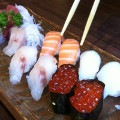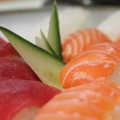Sushi – Just a load of raw fish?
Introduction
Sushi – that’s raw fish, right? WRONG! Sushi is often incorrectly labelled as raw fish! In reality, dishes that come under the title of ‘sushi’ are usually bite-sized morsels of pressed rice with various toppings and fillings that can include seafood (both cooked and raw) as well as vegetables and eggs (we’re not even going to go into chirashizushi – ‘scattered sushi’).
Nigiri, Maki, Tamaki
 Sushi is a popular subdivision of Japanese cuisine and is most commonly eaten in the form of Nigiri, Tamaki or Maki, which can be simplistically described as different shapes of sushi.
Sushi is a popular subdivision of Japanese cuisine and is most commonly eaten in the form of Nigiri, Tamaki or Maki, which can be simplistically described as different shapes of sushi.
Nigiri is the most recognisable form of sushi, where the rice has been pressed into a small oblongs with a topping draped over it. A little wasabi is often added between the rice and the topping. Sometimes, toppings are tied onto the rice bundle with a thin strip of nori. Nigiri are typically served in pairs.
 Maki are a popular roll-form of sushi, particularly in the USA, where ‘California Rolls’ (a type of maki) were first made. Maki are rolled with the aid of a bamboo sushi-mat and the roll-shape of the Maki Sushi enables them to contain a number of fillings, mixing vegetables and fish. Maki usually have nori as the outer layer, but are sometimes inverted, with the rice forming the outer layer, finished with fish roe or sesame seeds. The California Roll is an inverted roll that usually contains avocado, crabmeat and mayonnaise.
Maki are a popular roll-form of sushi, particularly in the USA, where ‘California Rolls’ (a type of maki) were first made. Maki are rolled with the aid of a bamboo sushi-mat and the roll-shape of the Maki Sushi enables them to contain a number of fillings, mixing vegetables and fish. Maki usually have nori as the outer layer, but are sometimes inverted, with the rice forming the outer layer, finished with fish roe or sesame seeds. The California Roll is an inverted roll that usually contains avocado, crabmeat and mayonnaise.
 Tamaki are also known as hand rolls, and are a variation on Maki. The rice and sushi fillings are wrapped into a cone shape with yaki nori forming the outer layer. The conical shape of Tamaki means that it is usually eaten by holding the sushi roll like an ice-cream cone. Like Maki, hand rolls can have many fillings and combinations of fillings.
Tamaki are also known as hand rolls, and are a variation on Maki. The rice and sushi fillings are wrapped into a cone shape with yaki nori forming the outer layer. The conical shape of Tamaki means that it is usually eaten by holding the sushi roll like an ice-cream cone. Like Maki, hand rolls can have many fillings and combinations of fillings.
Common Ingredients
Sushi Rice
Sushi Rice is prepared by firstly washing and soaking the rice prior to cooking. When the rice is cooked, the hot rice is seasoned with sweetened rice vinegar, stirred constantly whilst simultaneously being fanned. The fanning action cools the rice quickly and gives the rice a desirable shine; perfect for making sushi. It is important not to use a metal bowl for the seasoning and cooling process, as this will taint the flavour of the rice.
Yaki Nori
Yaki Nori is roasted seaweed, and is predominantly used in making sushi. This wafer-thin seaweed has a crisp texture that quickly fades after combining with the sushi rice, so eat your sushi soon after making it for ultimate freshness!
Wasabi
Wasabi is a Japanese horseradish, which usually has a green colouring and wasabi paste is often served with sushi. However, due to the high demand for wasabi, many modern wasabi pastes are a mixture of horseradish, mustard and food colouring. Wasabi has a strong ‘nose-heat’, rather like horseradish, and should be used sparingly unless you are used to it!
Pickled Ginger (Sushi Gari)
Gari is a sweet, thinly-sliced pickled ginger that can take on a pink hue due to the pickling process. Gari is often served with sushi as a palate-cleanser, to be eaten between different sushi so that the different flavours may be enjoyed to their fullest.
Common Sushi Toppings
- Tamago – Egg
- Sake – Salmon
- Unagi – Sweet Braised Eel
- Maguro/Toro – Tuna
- Hamachi – Yellowtail
- Saba – Mackerel
- Ika – Squid
- Tako – Octopus
- Ebi/Amaebi – Shrimp
- Kani – Crab
